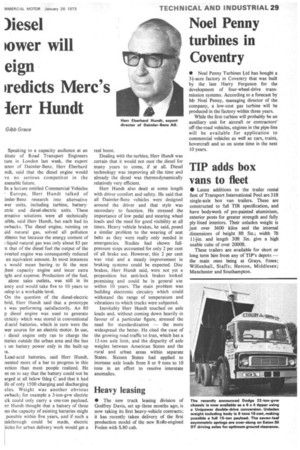Mesel lower will eign Iredicts Merc's Ierr Hundt
Page 31

If you've noticed an error in this article please click here to report it so we can fix it.
Gibb Grace
Speaking to a capacity audience at an titute of Road• Transport Engineers Lure in London last week, the export xtor of Daimler-Benz, Herr Eberhard mdt, said that the diesel engine would ve no serious competitor in the eseeable future.
In a lecture entitled Commercial Vehicles . Europe, Herr Hundt talked of imler-Benz research into alternative wer units, including turbine, batteryctric and diesel-electric units. These ernative solutions were all technically sible, said Herr Hundt, but each had its twbacks. The diesel engine, running on uid natural gas, solved all pollution klems but because the energy content of liquid natural gas was only about 85 per n that of the diesel fuel the output of the averted engine was consequently reduced an equivalent amount. In most instances s would mean having to fit the next r,hest capacity engine and incur extra ight and expense. Production of the fuel, alone sales outlets, was still in its 'ancy and would take five to 10 years to velop to a workable level.
On the question of the diesel-electric brid, Herr Hundt said that a prototype s was performing satisfactorily. An 80 p diesel engine was used to generate ctricity which was stored in conventional .d-acid batteries, which in turn were the wer source for an electric motor. In use, ! diesel engine only ran to charge the tteries outside the urban area and the bus 1 on battery power only in the built-up !a.
Lead-acid batteries, said Herr Hundt, !sented more of a bar to progress in this .ection than most people realized. .He nt on to say that the battery could not be arged at all below Odeg C and that it had ife of only 1500 charging and discharging cies. Weight was another obvious twback; for example a 3-ton-gvw electric ick could only carry a one-ton payload. ;IT Hundt thought that a battery of three es the capacity of existing batteries might possible within five years, and if such a akthrough could be made, electric 'cles for urban delivery work would get a real boost.
Dealing with the turbine, Herr Hundt was certain that it would not oust the diesel for many years to come, if at all. Diesel technology was improving all the time and already the diesel was thermodynamically relatively very efficient.
Herr Hundt also dealt at some length with driver comfort and safety. He said that all Daimler-Benz vehicles were designed around the driver and that style was secondary to function. He stressed the importance of low pedal and steering wheel loads and the need for good visibility at all times. Heavy vehicle brakes, he said, posed a similar problem to the wearing of seat belts as they were really only needed in emergencies. Studies had shown fullpressure stops accounted for only 2 per cent of all brake use. However, this 2 per cent was vital and a steady improvement in braking systems could be expected. Disc brakes, Herr Hundt said, were not yet a proposition but anti-lock brakes looked promising and could be in general use within 10 years. The main problem was building electronic circuitry which could withstand the range of temperature and vibrations to which trucks were subjected.
Inevitably Herr Hundt touched on axle loads and, without coming down heavily in favour of a particular figure, stressed the need for standardization the more widespread the better. He cited the case of the growing road traffic to Iran, which has a 13-ton axle limit, and the disparity of axle weights between American States and the rural and urban areas within separate States. Sixteen States had applied to increase axle loads from 8 or 9 tons to 10 tons in an effort to resolve interstate anomalies.




























































































